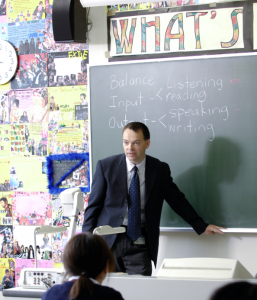 The largest class I have ever taught was about 15 years ago. It was an Oral Communication high school class of 52 students held in the Language Lab (LL), which incidentally only had 48 desks with headsets. Now that was an interesting challenge. I usually had 4 students sitting near the front of the room huddled around a cassette tape player while others listened through the sound system on their headsets. I had to substitute students into the main area like players in a football match. The biggest problem in super-size classes is that I couldn’t connect with all of the students, and I began to lose the students who needed personal attention but didn’t get any or didn’t get nearly enough.
The largest class I have ever taught was about 15 years ago. It was an Oral Communication high school class of 52 students held in the Language Lab (LL), which incidentally only had 48 desks with headsets. Now that was an interesting challenge. I usually had 4 students sitting near the front of the room huddled around a cassette tape player while others listened through the sound system on their headsets. I had to substitute students into the main area like players in a football match. The biggest problem in super-size classes is that I couldn’t connect with all of the students, and I began to lose the students who needed personal attention but didn’t get any or didn’t get nearly enough.

My other “large” Oral Communication classes were university classes of 35 students. In these classes, I tried many strategies from the standard to the sometimes silly in order to connect with more students:
- Use a bigger voice, greater intonation, more gestures and animated expressions to reach students in the back of the class.
- Keep a class seating/name chart in front of me at all times. It looks like a big BINGO sheet with student names and any unique tidbits of information I pick up about students from their homework or conversations in class. I might write, “dog- “Puffy” or PT job – Starbucks. Whenever I worked little bits of their real lives into my examples or explanations, everyone would notice, and I could feel the energy pick up in class.
- Move around a lot more throughout the room. I would cruise around a lot, or plant myself at the back of the room or near the “low concentration zones” (chatty students) in order to try to keep a connection with the outliers.
- Warn them at the beginning of the year (when they are most open to new ideas) that they will be moving around in my class. This meant keeping aisles and desks somewhat free of clutter (“leave your coats or big bags in the back or on the side of the room”). I have 90 minutes classes and so beyond the regular check with a partner next to you or behind you, I also try to make 2 or 3 “Stand up and move” changes per lesson to give them new partners to work with.
- Take advantage of large groups by doing group surveys, group discussions and group reports. Having students put their heads down and hands up to vote always resulted in honest answers. Having groups choose a leader, a secretary and a reporter created motivational expectations.
- Play team games. Three groups of 12 was fun for most people if I could inspire their teams’ competitive nature, and even more fun if I could (secretly) make the teams somewhat even.
In a nutshell, with bigger classes, I try to make everything bigger, while at the same time trying to connect with as many individuals as possible. What strategies work for you?





 There were two young Catalans at my gym who would while away their time on the exercise bicycles and rowing machines speaking English to each other. It was dreadful, highly accented and very unidiomatic English – but English, hours of it.
There were two young Catalans at my gym who would while away their time on the exercise bicycles and rowing machines speaking English to each other. It was dreadful, highly accented and very unidiomatic English – but English, hours of it.
 Encouraging learners to use English outside of class is like getting students to do the sort of good homework that I described in my previous post: homework that grows naturally out of the lesson, doesn’t feel like homework, and often isn’t even called homework. The idea is to get students using English on their own in their own way and as this needs to be encouraged, the teacher should not correct or evaluate such effort — unless students ask for it. Instead, such individual effort needs to be nurtured, encouraged, and praised.
Encouraging learners to use English outside of class is like getting students to do the sort of good homework that I described in my previous post: homework that grows naturally out of the lesson, doesn’t feel like homework, and often isn’t even called homework. The idea is to get students using English on their own in their own way and as this needs to be encouraged, the teacher should not correct or evaluate such effort — unless students ask for it. Instead, such individual effort needs to be nurtured, encouraged, and praised.